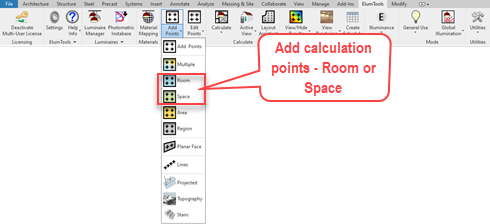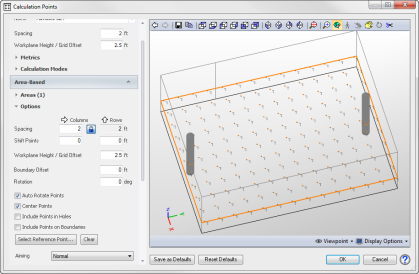Add Calculation Points_Room or Space
|
Add calculation points to any single Room or Space by selecting the Add Points command with the Room or Space option, followed by a click on the Room or Space indicator in Revit (Rooms or Spaces must be visible). This sequence can also be performed in reverse by selecting a Room or Space (or multiple) in Revit followed by the Add Points button on the main toolbar. This bypasses the need to access the specific command from the menu.
If all Rooms or Spaces will use the settings, you can window across as many as you like in Revit, filter the selection for only Rooms or Spaces and then select the main Add Points button. |

|
Rooms and Spaces must be in the host model when working with linked models. Revit does not translate this information across linked models. If both Rooms and Spaces are present, it is base practice to select one or the other to assign to your lighting calculations, then hide the unused element. If both are visible it can get confusing when selecting areas for calculation.
Calculation point dialog - Room or Space
Once the Room(s) or Spaces(s) have been selected, the Add Calculation Points dialog will appear for you to assign specific details to the calculation grid. Typical input will be Point spacing and Workplane height. By default, the illuminance Metric is selected and all Modes are active (General Use, Emergency, Daylight and Horticulture), for the grid of points. You can make changes if necessary by opening these sections of the dialog.
Specific details with regard to point locations can be accessed from the Area-Based section of the dialog. Center Points and Auto Rotate Points are selected by default. You may wish to include a Boundary Offset to move points away from walls or intersections. Details on all of the additional settings can be found in the general Add Calculation Points topic.

